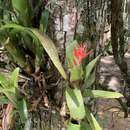en
names in breadcrumbs


Aechmea nudicaulis is a bromeliad species in the genus Aechmea, which is often used as an ornamental plant.[3] This species is native to Central America, the West Indies, central and southern Mexico, and northern and central South America.[2][4][5][6][7][8][9][10][11][12][13][14][15][16][17]
The following varieties are recognized :[2]
A number of cultivars derived from this species are commercially available. These are either selected forms, or hybrids arising from crosses with other species, including:
Aechmea nudicaulis is a bromeliad species in the genus Aechmea, which is often used as an ornamental plant. This species is native to Central America, the West Indies, central and southern Mexico, and northern and central South America.
The following varieties are recognized :
Aechmea nudicaulis var. aequalis L.B.Sm. & Reitz, 1963 - Espírito Santo Aechmea nudicaulis var. cuspidata Baker, 1879 - Brazil, Guyana, Venezuela, Ecuador Aechmea nudicaulis var. nordestina J.A. Siqueira & Leme, 2006 - northeastern Brazil Aechmea nudicaulis var. nudicaulis - most of species rangeA number of cultivars derived from this species are commercially available. These are either selected forms, or hybrids arising from crosses with other species, including:
Aechmea 'Parati' Aechmea 'Rakete'